Key points
- The hyper-yielding cereals project has set new benchmarks for productivity in irrigated feed wheat and barley crops in Tasmania
- The benchmarks are 13 to 13.5 tonnes per hectare for wheat and more than 10t/ha for barley
- Four winter wheat and two spring barley lines have been identified to help growers achieve the new yield benchmarks
- Yields from experimental trial plots peaked at 17.27t/ha for wheat, which is believed to be the Australian record, and 12.62t/ha for barley
A four-hectare site carved from a wheat crop at Hagley in north-central Tasmania has captured the imaginations of grain growers across the country.
This is because the patch of red soil in the high-rainfall zone (HRZ) was the epicentre of the GRDC-invested hyper-yielding cereals project, and home to its main trial site for the past four years.
There, 1000 trial plots testing new high-performance cereal lines and agronomic strategies have recast on-farm aspirations for crop productivity and profitability in Australia’s high-rainfall cropping areas.
Foundation for Arable Research (FAR) Australia managing director Nick Poole, who led the project in collaboration with Southern Farming Systems, considers the step-change in yield potential it has provided.
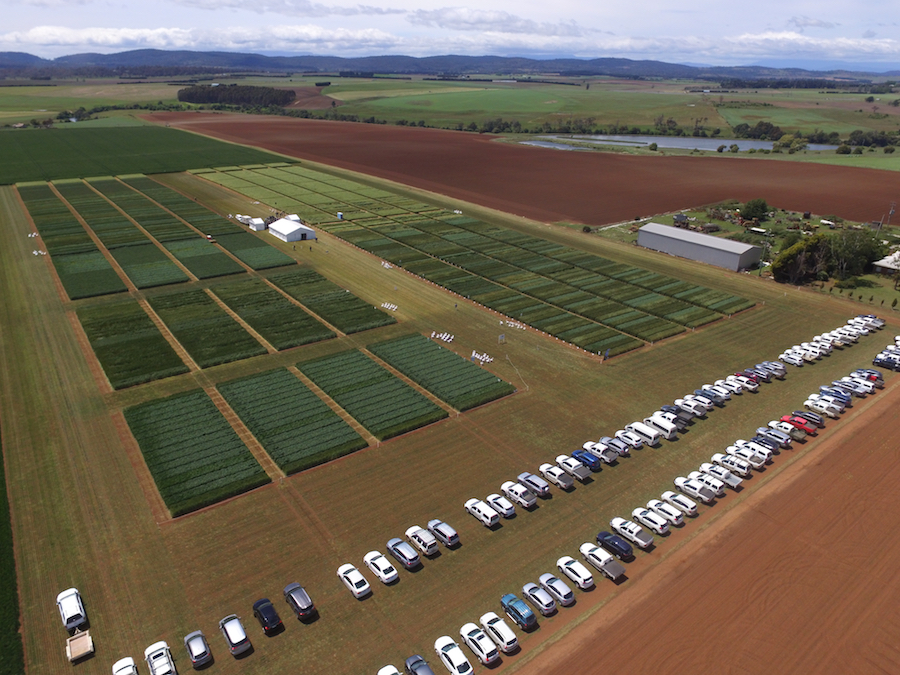
The main trial site for the hyper-yielding cereals project at Hagley, Tasmania. Photo: FAR Australia
The project has set new benchmarks for productivity in irrigated feed wheat and barley crops in Tasmania, Mr Poole says.
The new benchmarks, based on consistent findings from three years of trials, are 13 to 13.5 tonnes per hectare for wheat and more than 10t/ha for barley, he says.
However, the trials also show it is possible to exceed these indicators of cereal production potential, with yields from the experimental plots peaking at 17.27t/ha for wheat (believed to be the Australian record) and 12.62t/ha for barley. In theory, higher yields could be achieved for irrigated feed wheat and barley. The trials testing cereal performance used supplementary irrigation only, Mr Poole says.
He says the research, development and extension (RD&E) effort, and the benchmarks it has established, aims to close the yield gap between potential and actual crop yields for feed wheat and barley in Tasmania.
This was the main objective of the project since the average yield for red grain feed wheat in Tasmania prior to 2015 was 4.4t/ha, and the state remains a net importer of cereal grain. For example, Tasmania produces about 60,000 to 80,000t of cereal grain a year and imports 150,000t.
“A major aim was to reduce the dependency of end users such as the dairy industry on the federal government subsidising transport costs for imported grain,” Mr Poole says.
“Despite a more suitable climate for grain production and much higher yield potential than the mainland, the average yield of feed grain cereals was below its potential for the climate and soils in Tasmania.
“The project was set up to identify new feed cereal germplasm and management approaches that could lift the state’s feed grain productivity.”
Helping growers achieve the new yield benchmarks is germplasm road-tested at the main trial site, as well as four ‘focus farms’. These Tasmanian farms hosted trials at Hagley, Campbell Town, Sisters Creek and Nile.
The trial program examined Australian and international germplasm candidates, specifically selected for Tasmanian growing conditions, sourced from the mainland and the UK.

FAR Australia managing director Nick Poole led the hyper-yielding cereals project in collaboration with Southern Farming Systems. Photo: Clarisa Collis
High performance varieties
“Four winter wheat and two spring barley lines have been identified to underpin the benchmarks in productivity,” Mr Poole says.
These were discovered in the project’s initial two year-phase (2016-2017), which saw researchers compare the new germplasm with cereal varieties predominantly grown in Tasmania: SQP Revenue and Manning wheat, and Westminster barley.
The wheat and barley germplasm was then screened for four main attributes: high yield, straw strength to reduce susceptibility to lodging, disease resistance and plant development (phenology) suited to April sowing in Tasmania.
Meeting these selection criteria were the wheat lines RGT Relay, RGT Accroc, Annapurna and RGT Calabro, as well as the barley lines Rosalind and RGT Planet. Annapurna wheat is in the process of being commercialised.
But critical to securing the yield potential of this high-performance germplasm are the agronomic strategies developed through the project, which were put to the test in three years of trials.
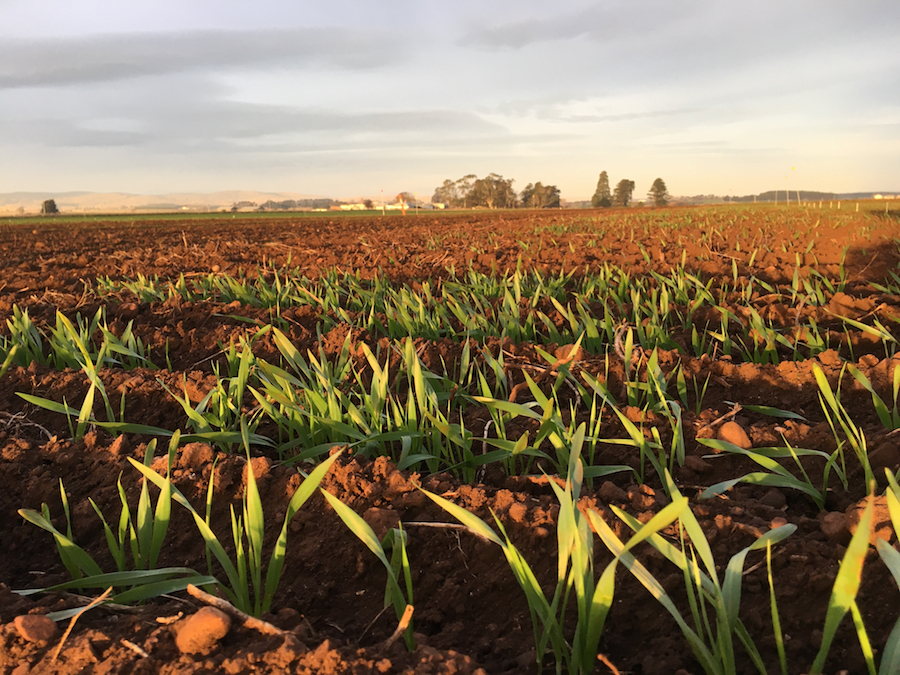
Barley emerging from experimental trials plots in north-central Tasmania. Photo: FAR Australia
Canopy management
Mr Poole says the R&D explored crop canopy management options because cereals producing more than 10t/ha are prone to lodging and require increased straw strength to support high yields.
“Keeping 10t/ha crops standing was a major objective of the research,” he says. “Cereal crops in Tasmania also tend to have larger, slower-growing canopies compared with those on the mainland, particularly with irrigation.
Intervention with plant growth regulators and knowledge of canopy management to promote robust straw strength is essential to achieving the yield potential of some hyper-yielding varieties.
Testing different tactics on cereal varieties with low straw strength, Manning and RGT Accroc wheat, the study identified two approaches that effectively delayed or prevented crop lodging.
These included applying the plant growth regulators (PGR) Moddus and Errex at growth stage 31 to 32 at recommended label rates, or dividing the same amount of active ingredient between two applications at GS30 or start of stem elongation and at GS32 or second node.
Mr Poole says split PGR applications were more effective than a single application, particularly where wheat grown for grain only (not grazing) was sown in early April.
The trials also highlighted that time of sowing, particularly delaying sowing from early to late April, was an effective tactic for reducing lodging.
For example, sowing RGT Accroc wheat in early April resulted in high rates of lodging, the severity of which increased with plant population density. However, where the same variety was sown in late April, there was no lodging, and the effect of plant population (70 to 185 plants per square metre) on lodging was neutral.
But for varieties less susceptible to lodging, such as RGT Relay and RGT Calabro wheat, the highest yields were achieved where crops were sown in late April with higher plant populations. Sowing these varieties at populations of 180 to 190 plants/m2 lifted yields by 1t/ha compared with populations below 100 plants/m2.
“Project results demonstrated that using PGRs to prevent lodging in April-sown crops could generate yield gains of more than 2t/ha, but more typically the yield gain was 1t/ha.” Grazing was found to provide “significant advantages” in preventing lodging where wheat was sown in early April, especially in varieties with weaker straw, such as RGT Accroc.
“Grazing was frequently associated with the lowest grain yields, but depending on dry matter prices, some of the better overall gross margins,” he says.
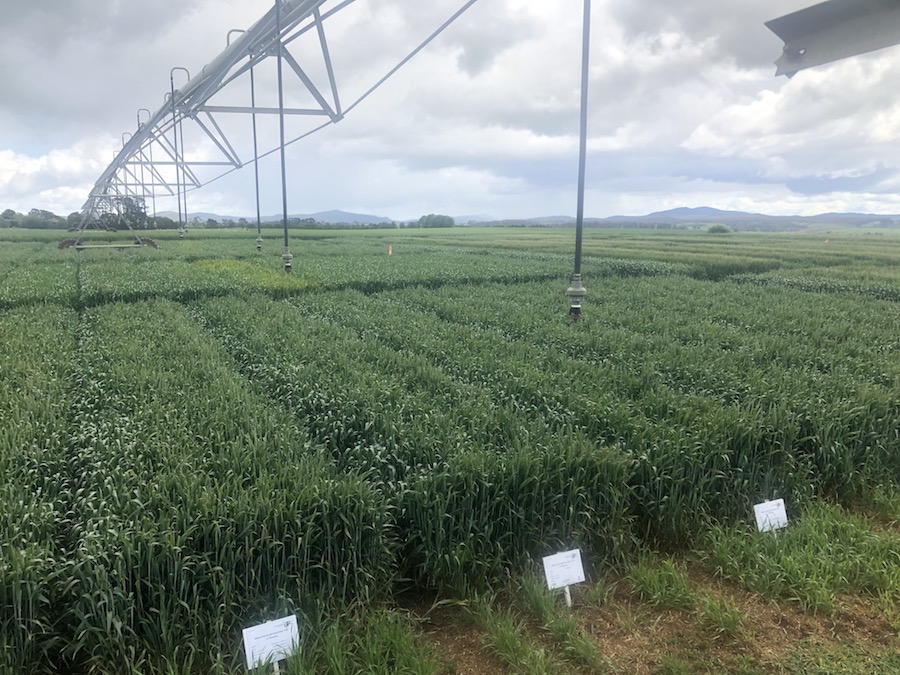
Supplementary irrigation was used in the trials testing cereal performance. Photo: FAR Australia
Fungicide strategy
Mr Poole says disease management was another major focus of the study since Tasmanian crops are vulnerable to high pressure from disease-causing fungal pathogens as a consequence of the state's high-rainfall climate and long growing season.
Cereal cropping generally runs from April to January (early barley harvest) and as late as March.
“The growing season in Tasmania is more disease-prone than any other environment in Australia,” he says.
Mr Poole says the strategies developed for the timing of fungicide applications are “crucial for optimising the productivity and profitability of hyper-yielding cereals”.
The disease-control strategy for wheat comprises three fungicide applications at GS31 or first node, GS39 or flag leaf emergence, and GS59 or head emergence. The strategy for barley comprises two fungicide sprays at GS31 or first node and GS49 or awn tipping.
Trials in the final two years of the project (2018 and 2019) showed the return on fungicide investment for the hyper-yielding wheat lines was typically $3 to $4 for every dollar spent.
“But for some cultivars, such as DS Bennett, the return on fungicide expenditure was much higher at $13 return for every dollar spent,” he says.
The exception to this finding was RGT Planet barley. Trials showed fungicide investment returns from this variety were more variable, with expenditure returning $7 for every dollar spent in 2018 compared with about $3 in 2019.
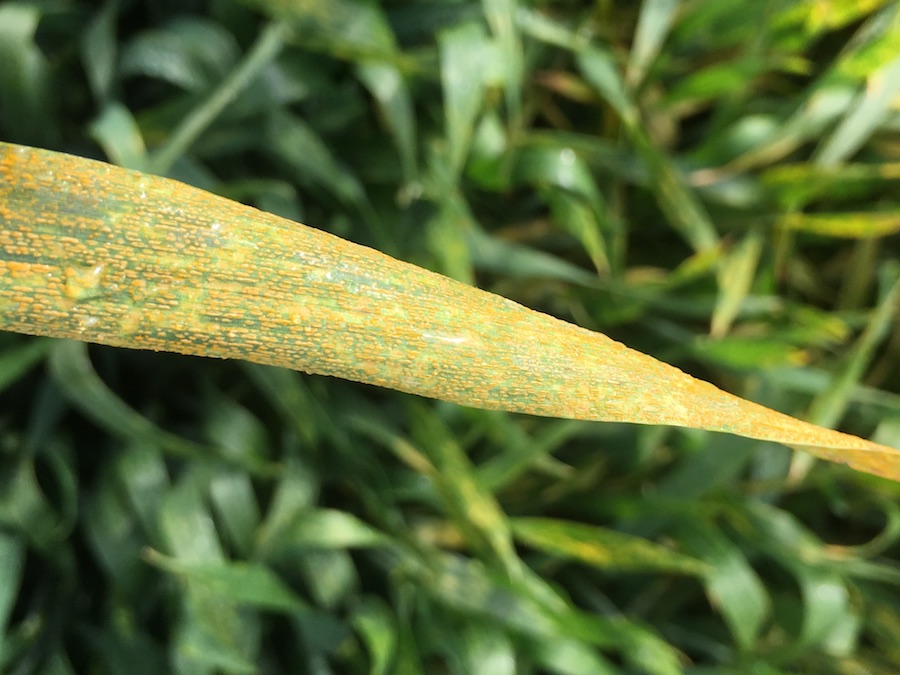
The timing of fungicide applications for controlling crop diseases, such as stripe rust, is crucial for optimising the productivity and profitability of hyper-yielding cereals. Photo: FAR Australia
Disease discovery
Mr Poole says the discovery of a seed-borne barley disease, Ramularia leaf spot, as well as options for its control have also positioned growers to improve barley cropping performance in Tasmania.
An endophytic fungus that grows inside barley plant tissue, Ramularia leaf spot tends to show symptoms in the crop’s advanced developmental stages later in the growing season.
The study found the disease was effectively controlled with mixtures of two fungicide groups: succinate dehydrogenase inhibitors (SDHI) and demethylation inhibitor (DMI) triazoles, such as Aviator Xpro fungicide applied at GS49 or awn emergence.
“The study was one of the first conducted in Australia to show control of this disease,” he says.
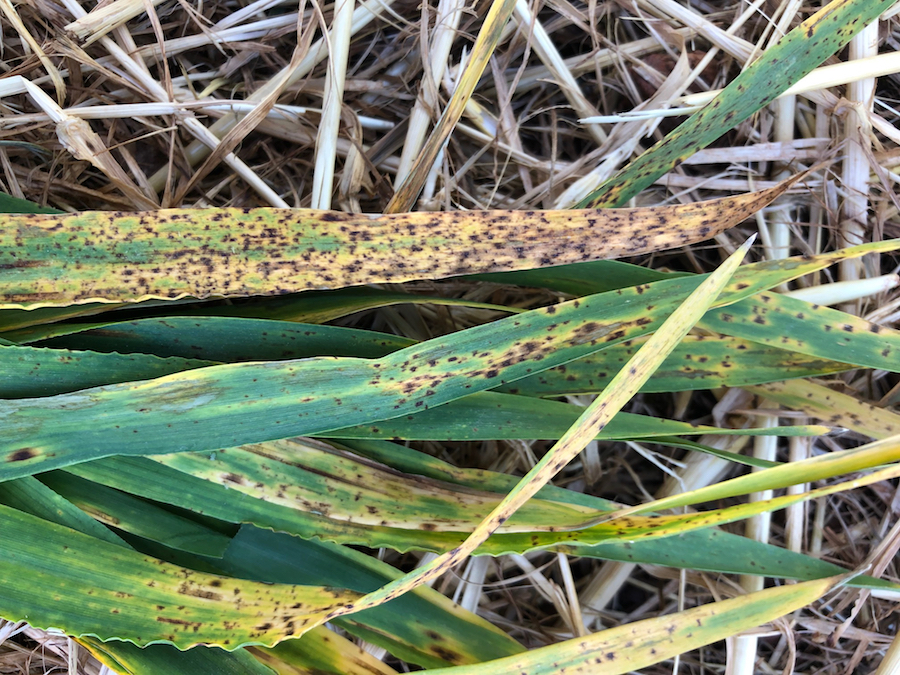
Seed-borne barley disease, Ramularia leaf spot, discovered in Tasmania. Photo: FAR Australia
Hyper-yielding nutrition
Mr Poole says an important finding was that Tasmanian cereals, which produced high yields, were mainly drawing on nitrogen reserves contained in fertile soils, rather than applied synthetic nitrogen fertiliser.
High soil fertility, including soil nitrogen, is characteristic of many farming systems in Tasmania, since they often feature a diverse enterprise mix with long-term rotation phases, including livestock, he says.
"In all years of the project, it was noted that high yields were evident in trial plots that received either no applied nitrogen fertiliser or relatively modest rates.
For instance, 2016 trials showed cereals yielded 14 to 17t/ha, even though applied fertiliser rates were relatively low at 150 to 220 kilograms of nitrogen per hectare.
“This indicated that the Hagley research site had high levels of inherent soil fertility due to the farm's cropping history, with long rotation phases of lucerne and large basal fertiliser applications for crops such as potatoes.”
Mr Poole says analysis showed that cereal crop canopies (at harvest) had frequently removed more that 300kg of nitrogen/ha from the soil.
“Yet the optimum rate of applied fertiliser was rarely more than 200kg of nitrogen/ha, even where fertiliser was applied at rates of 300 to 380kg of nitrogen/ha.
“While irrigated HRZ cereal crops might require higher nitrogen fertiliser rates, hyper-yielding wheat cannot be produced with artificial fertiliser alone.
“Diverse rotations leading to high soil fertility are essential to achieving high yields.”
He urges growers to position cereals in the rotation following a pulse, brassica or long-term pasture phase to maximise yields. “Recent analysis of wheat trial data in the UK also suggests that high-yielding wheat is produced on soils that would themselves generate high yields without the use of synthetic fertiliser.”
Feed grain quality
The research team collected more than 250 grain samples over four seasons to determine their quality, particularly the nutritive content of hyper-yielding cereals for sheep, cattle, poultry and pig enterprises.
Near-infrared spectroscopy analyses of the grain samples for major nutrients at the Feed Quality Service laboratory in Wagga Wagga, New South Wales, found that feed grain quality is determined by seasonal conditions and agronomic practices, rather than variety type.
Analysis also showed Tasmanian feed grain was one of the country’s top performers for quality, and that variable energy and starch levels detected in wheat samples could be used to differentiate prices for segregated feed grain.
Mainland adaptation
Mr Poole says the project, and other trials on the mainland, show hyper-yielding cereal varieties and agronomic strategies can be adapted to cropping areas across the country’s other HRZ growing regions.
For example, mainland trials indicate RGT Planet barley and RGT Accroc wheat are widely adapted to Australian agro-ecological zones beyond Tasmania. National Variety Trials show RGT Accroc and RGT Calabro wheat are adapted to HRZ areas across Victoria and South Australia, and Annapurna wheat yielded more than 11t/ha in 2019 trials at FAR Australia’s South Australian Crop Technology Centre at Millicent.
The influence of the research on mainland cropping regions was highlighted by the number of interstate visitors to the annual field day at the main Hagley trial site.
“Mainland visitor numbers grew each year and in the final two years they outnumbered the Tasmanian visitors,” Mr Poole says, adding that the field day attracted interstate growers not just from the HRZ, but also from medium and low-rainfall zones.
Building on the hyper-yielding cereals project in Tasmania that concluded last year, GRDC has invested in a new national initiative to push cereal and oilseed yield boundaries in cropping areas across the country.
This four-year Hyper Yielding Crops initiative aims to identify high-yielding cultivars and agronomic strategies for wheat, barley and canola in Victoria, South Australia, Tasmania, New South Wales and Western Australia.
Also leading the new project, Mr Poole says, “This initiative is about trying to improve productivity, increase yields and close what we believe is a significant yield gap (between potential and actual yields) in parts of Australia's high-rainfall zone.”
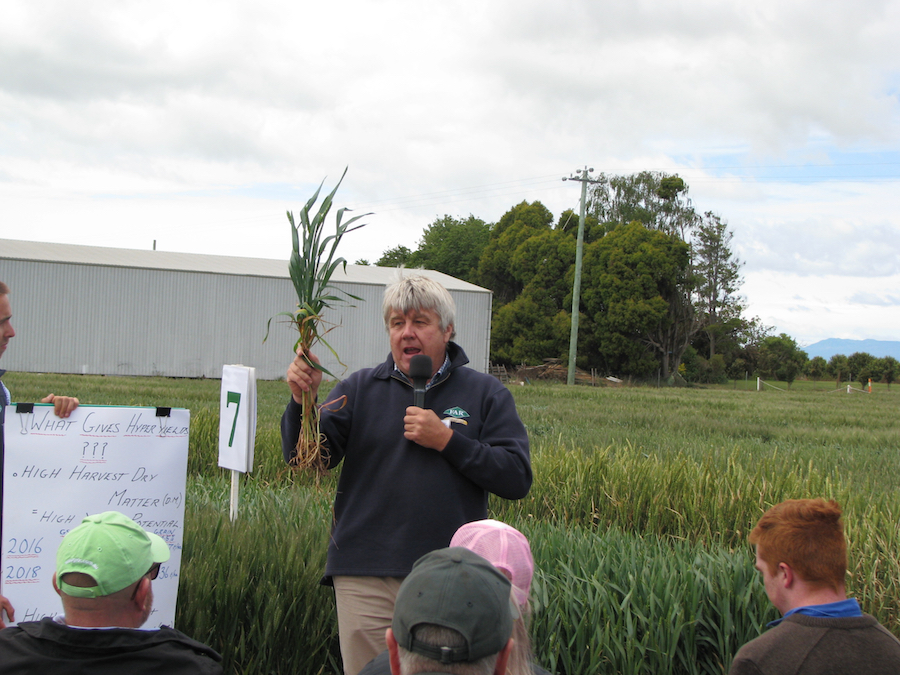
Nick Poole addressed grain growers from across the country at the hyper-yielding cereals field day at Hagley, Tasmania. Photo: FAR Australia
GRDC Research Code FAR 00003
More information: Nick Poole, 0499 888 066, nick.poole@faraustralia.com.au

























































